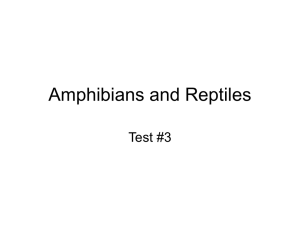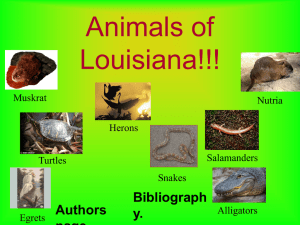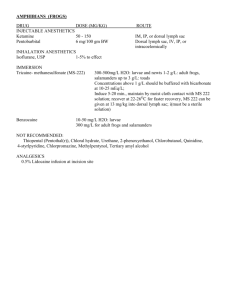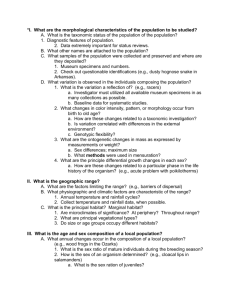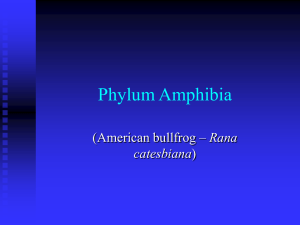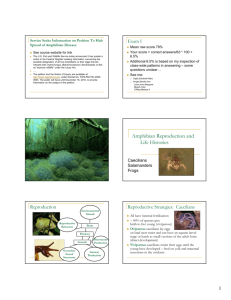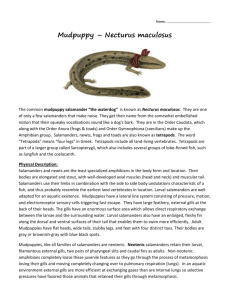Upper & Lower Elementary School Notes for Teachers
advertisement
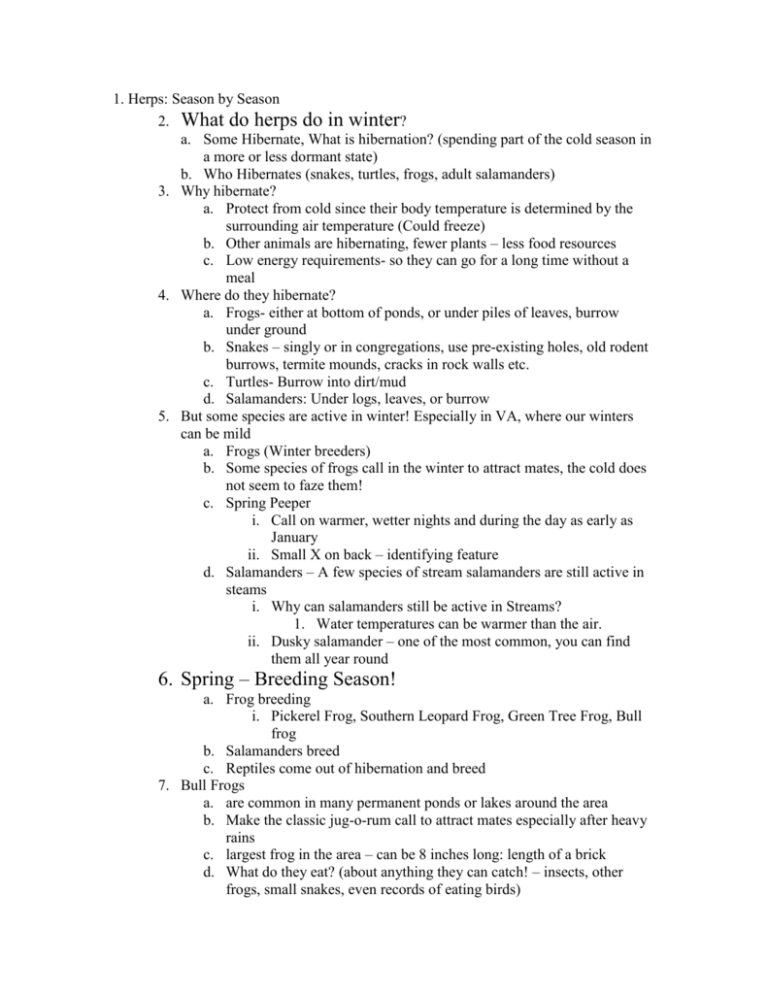
1. Herps: Season by Season 2. What do herps do in winter? a. Some Hibernate, What is hibernation? (spending part of the cold season in a more or less dormant state) b. Who Hibernates (snakes, turtles, frogs, adult salamanders) 3. Why hibernate? a. Protect from cold since their body temperature is determined by the surrounding air temperature (Could freeze) b. Other animals are hibernating, fewer plants – less food resources c. Low energy requirements- so they can go for a long time without a meal 4. Where do they hibernate? a. Frogs- either at bottom of ponds, or under piles of leaves, burrow under ground b. Snakes – singly or in congregations, use pre-existing holes, old rodent burrows, termite mounds, cracks in rock walls etc. c. Turtles- Burrow into dirt/mud d. Salamanders: Under logs, leaves, or burrow 5. But some species are active in winter! Especially in VA, where our winters can be mild a. Frogs (Winter breeders) b. Some species of frogs call in the winter to attract mates, the cold does not seem to faze them! c. Spring Peeper i. Call on warmer, wetter nights and during the day as early as January ii. Small X on back – identifying feature d. Salamanders – A few species of stream salamanders are still active in steams i. Why can salamanders still be active in Streams? 1. Water temperatures can be warmer than the air. ii. Dusky salamander – one of the most common, you can find them all year round 6. Spring – Breeding Season! a. Frog breeding i. Pickerel Frog, Southern Leopard Frog, Green Tree Frog, Bull frog b. Salamanders breed c. Reptiles come out of hibernation and breed 7. Bull Frogs a. are common in many permanent ponds or lakes around the area b. Make the classic jug-o-rum call to attract mates especially after heavy rains c. largest frog in the area – can be 8 inches long: length of a brick d. What do they eat? (about anything they can catch! – insects, other frogs, small snakes, even records of eating birds) 8. Life cycle of a frog (generalized using bullfrogs as an example) (encourage kids to name the next step) a. Call and mate in Spring b. Eggs are laid in a jelly mass just below surface of the water c. Eggs hatch and grow into large 3 inch tadpoles d. Tadpoles eat mostly algae, microscopic particles and vegetation e. Then they go through metamorphosis, loosing tail and developing front and hind limbs to become froglets f. Then they move onto land and become adults and begin to eat insects and other small animals 9. Spotted Salamanders a. Wetland salamanders i. like to breed in temporary ponds/ wetlands b. Warm early spring rains spark mass migrations to ponds c. Lay 200 eggs 10. Eastern Hog-nosed Snake a. Mate in either Spring (or Fall) b. Lay between 5-50 eggs in June or July c. Eggs will hatch 2 months after that and look just like smaller adults d. Hognose snakes have an upturned nose to dig for toads, its favorite food i. Since toads are normally poisonous, the hognose makes chemicals that stop the poison from working 11. Summer – Many reptiles and amphibians are active in the summer a. Summer is warmest season! b. Lots of sun for warmth c. Other animals for food d. Some Frogs are still breeding i. Bullfrogs, Spadefoot Toads, Grey Tree Frogs e. Reptiles most active 12. Worm snake – a. Very abundant snake found in most of Virginia b. lays eggs in early summer and hatching in late summer c. usually encountered when digging things up or uncovered when moving objects such as logs or mulch 13. Eastern Ratsnake a. This is one of the biggest snakes in the U.S. with records exceeding eight feet in length. But they are non-venomous and pose no threat to people b. frequent habitats used by humans c. Active by day d. They eat rats, birds and squirrels. e. How do the kill and eat their prey? i. They are powerful constrictors (Squeeze really hard), and kill by suffocating their prey and then swallowing them whole 14. Box turtle a. Box turtles are common residents of the woods in the southeastern U.S. b. Most common in the woods especially after rain. c. Males usually have red eyes Females have brown eyes. d. Box turtles feed on a variety of plants and small animals. e. Box turtles are extremely long-lived and some individuals may live for 50 years or more! 15. In Fall some salamanders breed! a. Marbled Salamander i. Female lays eggs in areas that fill with water to become puddles ii. She guards the eggs until rain covers them with water and they hatch. iii. Why do this? This ensures that the eggs hatch as soon as aquatic habitat is available, giving larvae a LARGE advantage over other amphibian larvae. Why is there this advantage? (because they are bigger and older, therefore can eat other larvae) 16. Snakes are most abundant in the fall! a. Snakes are actually more common in the fall than in any other season b. Most snakes in U.S. are born between July and September. c. So many babies are around and moving to find their first meals in fall d. Also, the adults move around more in search of good hiding places prior to hibernation. 17. Many herps move around to find homes to hibernate for the winter a. And the process starts all over again!

